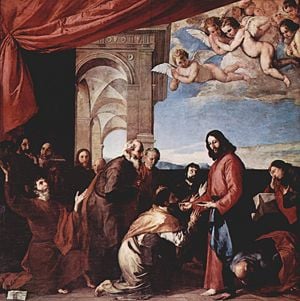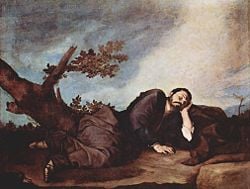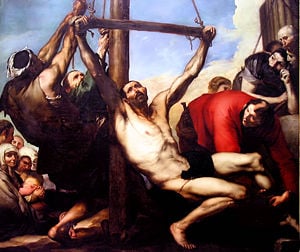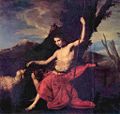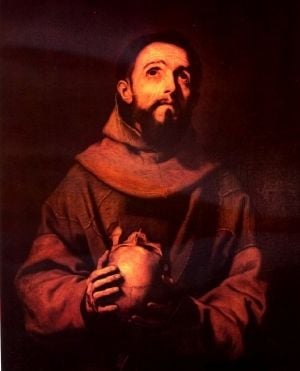Jusepe de Ribera
Jusepe de Ribera (January 12, 1591 - 1652) was a Spanish Tenebrist painter and printmaker, also known as José de Ribera in Spanish and as Giuseppe Ribera in Italian. He was also called by his contemporaries and early writers Lo Spagnoletto, or "the Little Spaniard." Ribera was a leading painter of the Spanish school, although his mature work was all done in Italy.
De Ribera was inventive in his subject matter, ranging through visionary spectacles, biblical themes, genre, portraits, mythological subjects, and portraits of ascetics and penitents.
His work demonstrates the profound change which took place in men's minds after the Protestant Reformation and the Council of Trent. In his paintings leanness, weariness, and abasement became the pictorial signs of the spiritual life.
Early life
Ribera was born near Valencia, Spain at San Felipe de Játiva, now named Xàtiva. His father was a shoemaker, perhaps on a large scale. His parents intended him for a literary or learned career, but he neglected these studies and is said to have apprenticed with the Spanish painter Francisco Ribalta in Valencia, although no proof of this connection exists. Longing to study art in Italy, he made his way to Rome via Parma, where he is recorded in 1611. According to one source, a cardinal noticed him drawing from the frescoes on a Roman palace facade, and housed him. Roman artists gave him the nickname "Lo Spagnoletto."
He became a follower of Michelangelo da Caravaggio's style, one of the so-called Tenebrosi, or shadow-painters, owing to the sharp contrasts of light and shade marking their style. He traveled to Parma, where he completed a painting on the subject of Jacob's Ladder, now in the Prado Museum, Madrid. Ribera lived in Rome from 1613-16, on the Via Margutta, and associated with other Caravaggisti, including Gerrit van Honthorst and Hendrik ter Brugghen. He then moved to Naples, to avoid his creditors, according to Giulio Mancini, who described him as extravagant. He may also have already arranged his marriage, to the daughter of a Neapolitan painter, Giovanni Bernardino Azzolino, in November, 1616.
Neapolitan period
The Kingdom of Naples was then part of the Spanish Empire, and ruled by a succession of Spanish Viceroys. Ribera's Spanish nationality aligned him with the small Spanish governing class in the city, and also with the Flemish merchant community, from another Spanish territory, who included important collectors of and dealers in art. Ribera began to sign his work as "Jusepe de Ribera, Español" or "Jusepe de Ribera, Spaniard." He was able quickly to attract the attention of the Viceroy, the Duke of Osuna, also recently arrived, who gave him a number of major commissions, which showed the influence of Guido Reni.
The period after Osuna was recalled in 1620 seems to have been difficult. Few paintings survive from 1620 to 1626; but this was the period in which most of his best prints were produced. These were at least partly an attempt to attract attention from a wider audience than Naples. His career picked up in the late 1620s, and he was accepted as the leading painter in Naples thereafter. Although Ribera never returned to Spain, many of his paintings were taken back by returning members of the Spanish governing class, for example the Duke of Osuna, and his etchings were brought to Spain by dealers. His influence can be seen in Velasquez, Murillo, and most other Spanish painters of the period.
He has been portrayed as selfishly protecting his prosperity, and is reputed to have been the chief in the so-called Cabal of Naples, his abettors being a Greek painter, Belisario Corenzio and the Neapolitan, Giambattista Caracciolo. It is said this group aimed to monopolize Napolitan art commissions, using intrigue, sabotage of work in progress, and even personal threats of violence to frighten away outside competitors such as Annibale Caracci, the Cavalier d'Arpino, Reni, and Domenichino. All of them were invited to work in Naples, but found the place inhospitable. The cabal ended at the time of Caracciolo's death in 1641.
Later life
From 1644, Ribera seems to have suffered serious ill-health, which greatly reduced his ability to work himself, although his workshop continued to produce. In 1647-8, during the Masaniello rising against Spanish rule, he felt forced to take refuge with his family in the palace of the Viceroy for some months. In 1651 he sold the large house he had owned for many years, and when he died in July 1652 he was in serious financial difficulties. His daughter had married in about 1644 a Spanish nobleman in the administration, who died soon after.
Gallery
Work
In his earlier style, founded sometimes on Caravaggio and sometimes on the wholly diverse method of Correggio, the study of Spanish and Venetian masters can be traced. Along with his massive and predominating shadows, he retained from first to last a great strength in local coloring. His forms, though ordinary and sometimes coarse, are correct; the impression of his works gloomy and startling. He delighted in subjects of horror. In the early 1630s his style changed away from strong contrasts of dark and light to a more diffused and golden lighting. Salvator Rosa and Luca Giordano were his most distinguished followers, who may have been his pupils; others were also Giovanni Do, Enrico Fiammingo, Michelangelo Fracanzani, and Aniello Falcone, who was the first considerable painter of battle-pieces.
Among Ribera's principal works could be named "St Januarius Emerging from the Furnace" in the cathedral of Naples; the "Descent from the Cross" in the Certosa, Naples, the "Adoration of the Shepherds" (a late work, 1650), now in the Louvre; the "Martyrdom of St Bartholomew" in the Prado; and the "Pieta" in the sacristy of San Martino, Naples. His mythologic subjects are often as violent as his martyrdoms: for example, "Apollo and Marsyas," with versions in Brussels and Naples, or the "Tityus" in the Prado . The Prado and Louvre contain numbers of his paintings; the National Gallery, London, three. He executed several fine male portraits and a self-portrait. He was an important etcher, the most significant Spanish printmaker before Goya, producing about forty prints, nearly all in the 1620s.
Notes
ReferencesISBN links support NWE through referral fees
- Brown, Jonathan. (1973). Jusepe de Ribera: prints and drawings; [catalogue of an exhibition] The Art Museum, Princeton University, October-November 1973. Princeton, N.J.: Princeton University. OCLC 781367 the standard work on his prints and drawings.
- Perez Sanchez, Alfonso E., Nicola Spinosa, and Andrea Bayer. 1992. Jusepe de Ribera, 1591-1652. New York: Metropolitan Museum of Art. ISBN 0870996479
- Scholz-Hänsel, Michael. (2000). Jusepe de Ribera, 1591-1652. Cologne: Könemann. ISBN 3829028725
- Ribera, José de. 1992. Jusepe de Ribera, 1591-1652. Napoli: Electa Napoli. ISBN 884353842X
- Williamson, Mark A. "The Martyrdom Paintings of Jusepe de Ribera: Catharsis and Transformation"; PhD Dissertation, Binghamton University, Binghamton, New York 2000 (available online at myspace.com/markwilliamson13732)
External links
- Biography of Ribera Spanisharts.com. Retrieved December 22, 2007.
- Jusepe de Ribera Artcyclopedia.com. Retrieved December 22, 2007.
- Jusepe de ribers Newadvent.org. Retrieved December 22, 2007.
- Jusepe de Ribera Wga.hu. Retrieved December 22, 2007.
- Hughes, Robert. 1992. Baroque Futurist Time.com. Retrieved December 27, 2007.
- Ribera Cgfa.sunsite.dk. Retrieved December 22, 2007.
- 26 Prints and drawings from San Francisco Museums. Retrieved December 15, 2007.
This article incorporates text from the Encyclopædia Britannica Eleventh Edition, a publication now in the public domain.
Warning: Default sort key "Ribera, Giuseppe" overrides earlier default sort key "Ribera, Jusepe de".
Credits
New World Encyclopedia writers and editors rewrote and completed the Wikipedia article in accordance with New World Encyclopedia standards. This article abides by terms of the Creative Commons CC-by-sa 3.0 License (CC-by-sa), which may be used and disseminated with proper attribution. Credit is due under the terms of this license that can reference both the New World Encyclopedia contributors and the selfless volunteer contributors of the Wikimedia Foundation. To cite this article click here for a list of acceptable citing formats.The history of earlier contributions by wikipedians is accessible to researchers here:
The history of this article since it was imported to New World Encyclopedia:
Note: Some restrictions may apply to use of individual images which are separately licensed.
